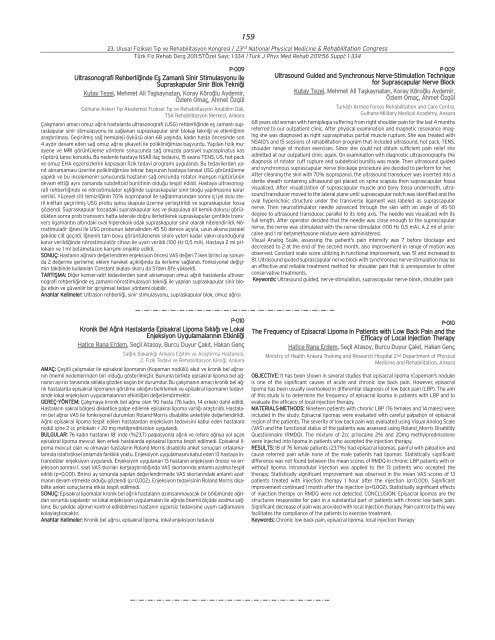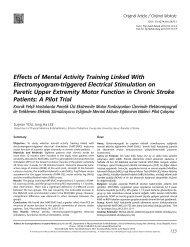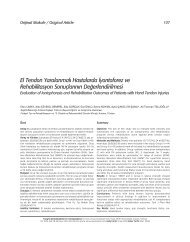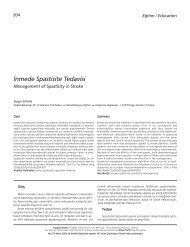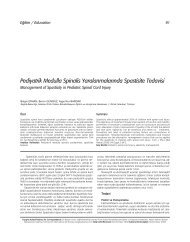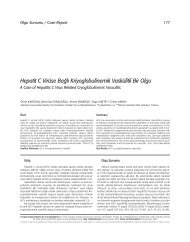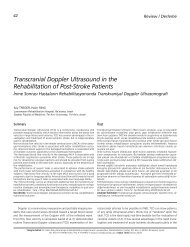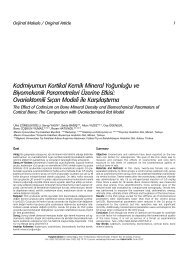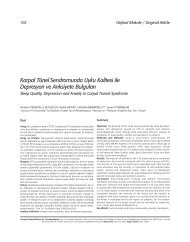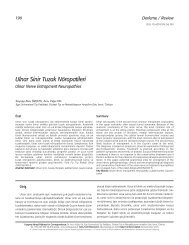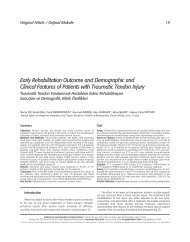‹nmeli Hastalarda Yaflflam Kalitesini Etkileyen ... - FTR Dergisi
‹nmeli Hastalarda Yaflflam Kalitesini Etkileyen ... - FTR Dergisi
‹nmeli Hastalarda Yaflflam Kalitesini Etkileyen ... - FTR Dergisi
Create successful ePaper yourself
Turn your PDF publications into a flip-book with our unique Google optimized e-Paper software.
159<br />
23. Ulusal Fiziksel T›p ve Rehabilitasyon Kongresi / 23 rd National Physical Medicine & Rehabilitation Congress<br />
Türk Fiz Rehab Derg 2011:57Özel Say›; 1-334 /Turk J Phys Med Rehab 2011:56 Suppl; 1-334<br />
P-009<br />
Ultrasonografi Rehberli¤inde Efl Zamanl› Sinir Stimulasyonu ile<br />
Supraskapular Sinir Blok Tekni¤i<br />
Kutay Tezel, Mehmet Ali Taflkaynatan, Koray Köro¤lu Aydemir,<br />
Özlem Omaç, Ahmet Özgül<br />
Gülhane Askeri T›p Akademisi Fiziksel T›p ve Rehabilitasyon Anabilim Dal›,<br />
TSK Rehabilitasyon Merkezi, Ankara<br />
Çal›flman›n amac› omuz a¤r›l› hastalarda ultrasonografi (USG) rehberli¤inde efl zamanl› supraskapular<br />
sinir stimulasyonu ile sa¤lanan supraskapular sinir blokaj› tekni¤i ve etkinli¤inin<br />
araflt›r›lmas›. Geçirilmifl sa¤ hemipleji öyküsü olan 68 yafl›nda, kad›n hasta öncesinde son<br />
4 ayd›r devam eden sa¤ omuz a¤r›s› flikayeti ile poliklini¤imize baflvurdu. Yap›lan fizik muayene<br />
ve MRI görüntüleme yöntemi sonucunda sa¤ omuzda parsiyel supraspinatus kas<br />
rüptürü tan›s› konuldu. Bu nedenle hastaya NSA‹‹ ilaç tedavisi, 15 seans TENS, US, hot pack<br />
ve omuz EHA egzersizlerini kapsayan fizik tedavi program› uyguland›. Bu tedavilerden yan›t<br />
al›namamas› üzerine poliklini¤imize tekrar baflvuran hastaya tan›sal USG görüntüleme<br />
yap›ld› ve bu incelemenin sonucunda hastan›n sa¤ omzunda rotator manflon rüptürünün<br />
devam etti¤i ayn› zamanda subdeltoid bursitinin oldu¤u tespit edildi. Hastaya ultrasonografi<br />
rehberli¤inde ve nörostimulator eflli¤inde supraskapular sinir blo¤u yap›lmas›na karar<br />
verildi. Yüzeyel cilt temizli¤inin 70% isopropanol ile sa¤lanmas›ndan sonra içi jel dolu steril<br />
k›l›ftan geçirilmifl USG probu spina skapula üzerine yerlefltirildi ve supraskapular fossa<br />
gözlendi. Supraskapular fossadaki supraskapular kas ve skapulaya ait kemik dokusu görüldükten<br />
sonra prob transvers hatta laterale do¤ru ilerletilerek supraskapular çentikte transvers<br />
ligamant›n alt›ndaki oval hiperekoik odak supraskapular sinir olarak nitelendirildi. Nörostimulaör<br />
i¤nesi ile USG probunun lateralinden 45 50 derece aç›yla, uzun aks›na paralel<br />
flekilde cilt geçildi. ‹¤nenin tam boyu görüntülenerek sinire yeteri kadar yak›n olundu¤una<br />
karar verildi¤inde nörostimulatör cihaz› ile uyar› verildi (100 Hz 0,5 mA). Hastaya 2 ml prilokain<br />
ve 1 ml betametazon kar›fl›m› enjekte edildi.<br />
SONUÇ: Hastan›n a¤r›s›n› de¤erlendiren enjeksiyon öncesi VAS de¤eri 7 iken birinci ay sonunda<br />
2 de¤erine gerileme; eklem hareket aç›kl›¤›nda da ilerleme sa¤land›. Fonksiyonel de¤iflimin<br />
takibinde kullan›lan Constant skalas› skoru da 51’den 81’e yükseldi.<br />
TARTIfiMA: Di¤er konservatif tedavilerden yan›t al›namayan omuz a¤r›l› hastalarda ultrasonografi<br />
rehberli¤inde efl zamanl› nörostimulasyon tekni¤i ile yap›lan supraskapular sinir blo-<br />
¤u etkin ve güvenilir bir giriflimsel tedavi yöntemi olabilir.<br />
Anahtar Kelimeler: Ultrason rehberli¤i, sinir stimulasyonu, supraskapular blok, omuz a¤r›s›<br />
P-010<br />
Kronik Bel A¤r›l› <strong>Hastalarda</strong> Episakral Lipoma S›kl›¤› ve Lokal<br />
Enjeksiyon Uygulamalar›n›n Etkinli¤i<br />
Hatice Rana Erdem, Seçil Atasoy, Burcu Duyur Çak›t, Hakan Genç<br />
Sa¤l›k Bakanl›¤› Ankara E¤itim ve Araflt›rma Hastanesi,<br />
2. Fizik Tedavi ve Rehabilitasyon Klini¤i, Ankara<br />
AMAÇ: Çeflitli çal›flmalar ile episakral lipoman›n (Kopeman nodülü) akut ve kronik bel a¤r›s›n›n<br />
önemli nedenlerinden biri oldu¤u gösterilmifltir. Bununla birlikte episakral lipoma bel a¤r›s›n›n<br />
ay›r›c› tan›s›nda s›kl›kla gözden kaçan bir durumdur. Bu çal›flman›n amac› kronik bel a¤r›l›<br />
hastalarda episakral lipoman›n görülme s›kl›¤›n› belirlemek ve episakral lipoman›n tedavisinde<br />
lokal enjeksiyon uygulamalar›n›n etkinli¤ini de¤erlendirmektir.<br />
GEREÇ-YÖNTEM: Çal›flmaya kronik bel a¤r›s› olan 90 hasta (76 kad›n, 14 erkek) dahil edildi.<br />
Hastalar›n sakral bölgesi dikkatlice palpe edilerek episakral lipoma varl›¤› araflt›r›ld›. Hastalar›n<br />
bel a¤r›s› VAS ile fonksiyonel durumlar› Roland-Morris disabilite anketiyle de¤erlendirildi.<br />
A¤r›l› episakral lipoma tespit edilen hastalardan enjeksiyon tedavisini kabul eden hastalara<br />
nodül içine 2 cc prilokain + 20 mg metilprednizolon uyguland›.<br />
BULGULAR: 76 kad›n hastan›n 18’ inde (%23,7) palpasyonla a¤r›l› ve refere a¤r›ya yol açan<br />
episakral lipoma mevcut iken erkek hastalarda episakral lipoma tespit edilmedi. Episakral lipoma<br />
mevcut olan ve olmayan hastalar›n Roland Morris disabilite anket sonuçlar› ortalamalar›nda<br />
istatistiksel anlamda farkl›l›k yoktu. Enjeksiyon uygulamas›n› kabul eden 13 hastaya intranodüler<br />
enjeksiyon uyguland›. Enjeksiyon uygulanan 13 hastan›n enjeksiyon öncesi ve enjeksiyon<br />
sonras› 1. saat VAS skorlar› karfl›laflt›r›ld›¤›nda VAS skorlar›nda anlaml› azalma tespit<br />
edildi (p=0,001). Birinci ay sonunda yap›lan de¤erlendirmede VAS skorlar›ndaki anlaml› azalman›n<br />
devam etmekte oldu¤u gözlendi (p=0,002). Enjeksiyon tedavisinin Roland Morris disabilite<br />
anket sonuçlar›na etkisi tespit edilmedi.<br />
SONUÇ: Episakral lipomalar kronik bel a¤r›l› hastalar›n az›msanmayacak bir bölümünde a¤r›dan<br />
sorumlu yap›lard›r ve lokal enjeksiyon uygulamalar› ile a¤r›da önemli ölçüde azalma sa¤lan›r.<br />
Bu flekilde a¤r›n›n kontrol edilebilmesi hastan›n egzersiz tedavisine uyum sa¤lamas›n›<br />
kolaylaflt›racakt›r.<br />
Anahtar Kelimeler: Kronik bel a¤r›s›, episakral lipoma, lokal enjeksiyon tedavisi<br />
P-009<br />
Ultrasound Guided and Synchronous Nerve-Stimulation Technique<br />
for Suprascapular Nerve Block<br />
Kutay Tezel, Mehmet Ali Taflkaynatan, Koray Köro¤lu Aydemir,<br />
Özlem Omaç, Ahmet Özgül<br />
Turkish Armed Forces Rehabilitation and Care Centre,<br />
Gulhane Military Medical Academy, Ankara<br />
68 years old woman with hemiplegia suffering from right shoulder pain for the last 4 months<br />
referred to our outpatient clinic. After physical examination and magnetic resonance imaging<br />
she was diagnosed as right supraspinatus partial muscle rupture. She was treated with<br />
NSAID’s and 15 sessions of rehabilitation program that included ultrasound, hot pack, TENS,<br />
shoulder range of motion exercises. Since she could not obtain sufficient pain relief she<br />
admitted at our outpatient clinic again. On examination with diagnostic ultrasonography the<br />
diagnosis of rotator cuff rupture and subdeltoid bursitis was made. Then ultrasound guided<br />
and synchronous suprascapular nerve blockage procedure are decided to perform for her.<br />
After cleaning the skin with 70% isopropanol, the ultrasound transducer was inserted into a<br />
sterile sheath containing ultrasound gel placed on spina scapula then suprascapular fossa<br />
visualized. After visualiziation of suprascapular muscle and bony fossa underneath, ultrasound<br />
transducer moved to the lateral plane until suprascapular notch was identified and the<br />
oval hyperechoic structure under the transverse ligament was labeled as suprascapular<br />
nerve. Then neurostimulator needle advanced through the skin with an angle of 45-50<br />
degree to ultrasound transducer, parallel to its long axis. The needle was visualized with its<br />
full length. After operator decided that the needle was close enough to the suprascapular<br />
nerve, the nerve was stimulated with the nerve stimulator (100 Hz 0.5 mA). A 2 ml of prilocaine<br />
and 1 ml betamethasone mixture were administered.<br />
Visual Analog Scale, assessing the patient's pain intensity was 7 before blockage and<br />
decreased to 2 at the end of the second month, also improvement in range of motion was<br />
observed. Constant scale score utilizing in functional improvement, was 51 and increased to<br />
81. Ultrasound guided suprascapular nerve block with synchronous nerve-stimulation may be<br />
an effective and reliable treatment method for shoulder pain that is unresponsive to other<br />
conservative treatments.<br />
Keywords: Ultrasound guided, nerve-stimulation, suprascapular nerve block, shoulder pain<br />
P-010<br />
The Frequency of Episacral Lipoma in Patients with Low Back Pain and the<br />
Efficacy of Local Injection Therapy<br />
Hatice Rana Erdem, Seçil Atasoy, Burcu Duyur Çak›t, Hakan Genç<br />
Ministry of Health Ankara Training and Research Hospital 2nd Department of Physical<br />
Medicine and Rehabilitation, Ankara<br />
OBJECTIVE: It has been shown in several studies that episacral lipoma (Copeman's nodule)<br />
is one of the significant causes of acute and chronic low back pain. However, episacral<br />
lipoma has been usually overlooked in differential diagnosis of low back pain (LBP). The aim<br />
of this study is to determine the frequency of episacral lipoma in patients with LBP and to<br />
evaluate the efficacy of local injection therapy.<br />
MATERIALS-METHODS: Nineteen patients with chronic LBP (76 females and 14 males) were<br />
included in the study. Episacral lipomas were evaluated with careful palpation of episacral<br />
region of the patients. The severity of low back pain was evaluated using Visual Anolog Scale<br />
(VAS) and the functional status of the patients was assessed using Roland_Morris Disability<br />
Questionnaire (RMDQ). The mixture of 2cc prilocaine 2% and 20mg methylprednisolone<br />
were injected into lipoma in patients who accepted the injection therapy.<br />
RESULTS: 18 of 76 female patients (23.7%) had episacral lipomas, painful with palpation and<br />
cause referred pain while none of the male patients had lipomas. Statistically significant<br />
difference was not found between the mean scores of RMDQ in chronic LBP patients with or<br />
without lipoma. ‹ntranodular injection was applied to the 13 patients who accepted the<br />
therapy. Statistically significant improvement was observed in the mean VAS scores of 13<br />
patients treated with injection therapy 1 hour after the injection (p=0.001). Significant<br />
improvement continued 1 month after the injection (p=0.002). Statistically significant effects<br />
of injection therapy on RMDQ were not detected. CONCLUSION: Episacral lipomas are the<br />
structures responsible for pain in a substantial part of patients with chronic low back pain.<br />
Significant decrease of pain was provided with local injection therapy. Pain control by this way<br />
facilitates the compliance of the patients to exercise treatment.<br />
Keywords: Chronic low back pain, episacral lipoma, local injection therapy


